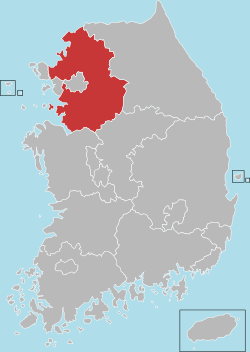Hwaseong, Gyeonggi
| Hwaseong 화성시 | ||
|---|---|---|
| Specific city | ||
| Korean transcription(s) | ||
| • Hangul | 화성시 | |
| • Hanja | 華城市 | |
| • Revised Romanization | Hwaseong-si | |
| • McCune–Reischauer | Hwasŏng-si | |
|
Gungpyeong Port | ||
| ||
 Location in South Korea | ||
| Coordinates: 37°11′59″N 126°49′53″E / 37.19972°N 126.83139°E | ||
| Country |
| |
| Province |
| |
| Metropolitan area | Sudogwon | |
| Administrative divisions | 4 eup, 10 myeon, 10 dong | |
| Area | ||
| • Total | 688 km2 (266 sq mi) | |
| Population (2015 Oct) | ||
| • Total | 586,896 | |
| • Density | 853/km2 (2,210/sq mi) | |
| • Dialect | Seoul | |
Hwaseong is a city in Gyeonggi Province, South Korea. It has the largest area of farmland of any city or county in Gyeonggi Province.[1] Seoul Subway Line 1 passes through Hwaseong, stopping at Byeongjeom Station.
History
Universal Studios
On November 27, 2007 the city was chosen as the site for the future Universal Studios South Korea theme park. Originally set to open in 2016, it will be the world's largest Universal Studios theme park, being larger than all the other four combined.[2] The USD $3.1 billion park is expected to create at least 58,000 new jobs.[3] In 2014, the project was put on hold. The plan was restarted in 2015, and K-Water (Korean Water Resources Corporation) was chosen as a business partner. Universal Studios South Korea is projected to open in 2020.[4]
Climate
Hwaseong city is located in the western area of the Korean Peninsula. The temperatures in winter are low along the coast since it is located in the lower plains and close to the Yellow Sea (West Sea), where the water is shallow.[5] Additionally, Siberian air flows directly into the western flatlands of the Korean peninsula, making several areas colder.
Demographics
Hwaseong is populated by 49% male South Korean citizens, 46% South Korean females, and 5% foreign residents. With 236,241 homes, there are on average 2.8 people per registered place of residence in the city. With the exceptions of Byeongjeom 2-dong, Dongtan 2-dong and Dongtan 3-dong, there is a larger number of males than females in every division of the city.[6]
Administrative divisions
Hwaseong has 4 towns (eup), 10 townships (myeon) and 10 neighborhoods (dong). Each eup and myeon is further divided into villages (ri). In October 2014, Namyang-dong was downgraded to an eup- the first case in South Korea.
| Place | Population (2016.06.30) | Household | Area (km2) |
|---|---|---|---|
| Sum | 619,766 | 236,241 | 689.7 |
| Bongdam-eup | 69,941 | 24,887 | 42.7 |
| Ujeong-eup | 18,090 | 8,101 | 59.7 |
| Hyangnam-eup | 70,374 | 28,560 | 50.0 |
| Namyang-eup | 26,917 | 11,615 | 67.0 |
| Maesong-myeon | 8,317 | 3,675 | 27.4 |
| Bibong-myeon | 5,863 | 2,810 | 38.5 |
| Mado-myeon | 6,762 | 3,347 | 31.7 |
| Songsan-myeon | 11,287 | 5,205 | 53.9 |
| Seosin-myeon | 6,993 | 3,639 | 43.2 |
| Paltan-myeon | 10,556 | 5,784 | 50.9 |
| Jangan-myeon | 10,983 | 5,297 | 67.7 |
| Yanggam-myeon | 4,235 | 2,237 | 31.1 |
| Jeongnam-myeon | 12,487 | 5,926 | 40.6 |
| Dongtan-myeon | 3,394 | 1,744 | 32.1 |
| Jinan-dong | 36,351 | 16,266 | 6.2 |
| Byeongjeom 1(il)-dong | 28,520 | 9,983 | 1.5 |
| Byeongjeom 2(i)-dong | 26,758 | 8,892 | 1.0 |
| Banwol-dong | 27,024 | 8,566 | 3.9 |
| Gibae-dong | 14,859 | 4,843 | 4.2 |
| Hwasan-dong | 23,494 | 9,137 | 11.6 |
| Dongtan 1(il)-dong | 53,494 | 18,728 | 5.3 |
| Dongtan 2(i)-dong | 37,246 | 11,669 | 2.2 |
| Dongtan 3(sam)-dong | 44,354 | 15,369 | 1.9 |
| Dongtan 4(sa)-dong | 61,526 | 19,961 | 14.1 |
Local products
Many special products are sold in the Hwaseong area that are different from other regions of Gyeonggi-do. There are many facilities that grow products ranging from honey melons to herbs. Additionally, meat and dairy products are also available. Hangwa is also made by local companies as a specialty.
Symbols
Notable residents
- Cha Bum-kun, South Korean football player
Sister cities
 Burnaby, British Columbia, Canada
Burnaby, British Columbia, Canada Weihai, China
Weihai, China Wujiang, China
Wujiang, China Phú Thọ Province, Vietnam
Phú Thọ Province, Vietnam
See also
References
- ↑ http://www.hscity.net/english/html/data/data05_01.asp
- ↑ http://koreatimes.co.kr/www/news/nation/2010/01/117_59398.html
- ↑ http://www.chron.com/disp/story.mpl/ent/5330802.html
- ↑ Park, Sangyoung (2015-12-22). "The korea Universal park will be opened at hwaseong".
- ↑ http://english.hscity.net/ Climate
- ↑ "2016년 인구현황". Hwaseong City Council. Retrieved 2016-06-30.
External links
| Wikimedia Commons has media related to Hwaseong. |
.jpg)


